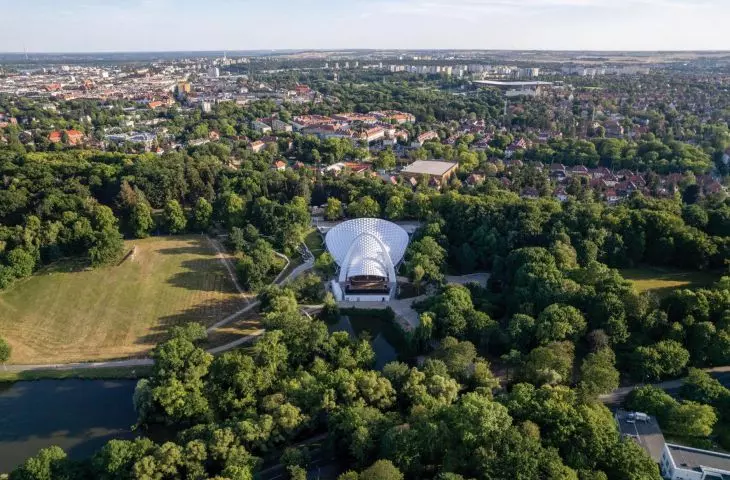Since ancient times, theatrical performances have taken place in places that were naturally conducive to the organization of shows, on hillsides, surrounded by nature and in harmony with it. Similarly, although already contemporary, it was in Szczecin's Jan Kasprowicz Park, where the first wooden stage was built on a natural slope next to Lake Rusalka as early as the 1930s. Today, the Summer Theater in Szczecin has lived to see modernization, thanks to which it can compete with the best European amphitheaters without complexes.
The Summer Theater is located in Szczecin's Jan Kasprowicz Park
photo: Piotr Krajewski
Last weekend, after two years of modernization, Szczecin held the grand opening of the Summer Theater named after the Polish queen of twist - Helena Majdaniec. The reconstructed facility was built in the 1970s, before which the city had at its disposal the aforementioned makeshift stage from the 1930s. However, residents dreamed of a real amphitheater, so it was thanks to their initiative that a project by Zbigniew Abrahamowicz was realized in 1975.
The proposal of the Szczecin architect was controversial, mainly due to the complex construction of a reinforced concrete parabolic arch inspired - according to the architect and creator of the "Abrahamowicz Project" initiative, Tomasz Sachanowicz - by the iconic Gateway Arch in Saint Louis in the United States, a nearly 200-meter-high form on the banks of the Mississippi River designed by Eero Saarinen.
The theater is located on Lake Rusalka
photo: Piotr Krajewski
The concrete structure was built over a period of three years by, among others, juniors, soldiers and inmates from local prisons. At this stage, the completion of the planned roof was abandoned; a new roof designed by Marcin Fiuk was built in 2000 during the summer renovation of the theater.
Forty years after the commissioning of the edifice designed by Zbigniew Abrahamowicz, in 2015 the Municipality of Szczecin and the Szczecin branch of SARP announced a two-stage, realization competition, the purpose of which, as emphasized in the regulations, was to increase the visual attractiveness and functionality of the Summer Theater. The competition jury, chaired by Kazimierz Łatak, awarded two honorable mentions and three prizes. The most important one, the first one, went to the London-based Flanagan Lawrence studio.
bird's eye view of the theater
Photo: Piotr Krajewski
The UK-based studio has a track record of buildings of similar type, including a concert shell for a symphony orchestra in San Diego and an award-winning acoustic block of soft, organic form in Littlehampton, England.
The most eye-catching element of the competition proposal is the new canopy, inscribed in an arc, which gently shelters the audience on one side and dynamically rises above the stage on the other. The culmination of the organic form is its intersection with the concrete arch.
The architects inscribed the new canopy into the original arch
photo: Piotr Krajewski
The form of the canopy is closely related to the poetics of the site, explains Przemyslaw Kolodziej, lead architect from the Flanagan Lawrence studio. - In front of a walker approaching the amphitheater from the eastern side, a perspective opens up at some point, in which a white arch structure, contrasting with everything around, emerges between the uniformly colored trees. The sensation is so strong that in an almost organic way the whole project has been subordinated to this feeling, the designer adds.
The geometry of the canopy adapts to the optimal shape of the auditorium, the existing arch and the picturesque terrain of the park
Photo: Piotr Krajewski
The geometry of the canopy, which adapts to the optimal shape of the auditorium, the existing arch and the picturesque terrain of the park, was created by using parametric computer techniques. The steel structure is covered with a technical rhomboid fabric on the outside and a specialized acoustic fabric on the inside.
The canopy gently shields the audience on one side, and on the other, above the stage - it rises dynamically
photo: Piotr Krajewski
The use of such an arrangement of materials and structures, as well as technical and lighting installations running between them (and invisible to the audience), is very innovative and was intended to create the best amphitheater in terms of acoustics and technology in Europe, and perhaps beyond, explains architect Jason Flanagan of London-based Flanagan Lawrence. - Guaranteeing high sound quality, the naturally ventilated amphitheater fits in with the new postcovid model for the operation of cultural venues, the co-author of the project concludes.
view from the audience to the stage
photo: Piotr Krajewski
The auditorium of the summer theater can now seat almost three thousand people (the number of seats is 2712), the entire investment cost 54 million zlotys. Will the facility become another architectural and cultural icon of the city?
















































